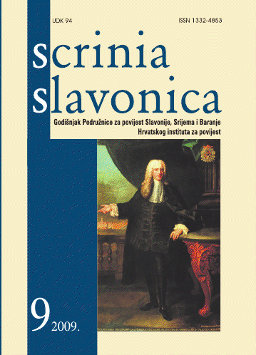Historicističke obnove crkve Svete Ane u Donjoj Vrijeski
Historicist renovations of St. Anna’s Church in Donja Vrijeska
Author(s): Dragan DamjanovićSubject(s): History
Published by: Hrvatski institut za povijest
Keywords: St. Anna’s Church; Veliki Bastaji; Donja Vrijeska; monument protection; Romanticism; Historicism; Neogothic style; Neobyzantine style; Vinko Rauscher; Ivan Kukuljević Sakcinski.
Summary/Abstract: St. Anna’s Church in Donja Vrijeska near Daruvar is one of the relatively few well-preserved gothic sacral buildings in Slavonia. It is a single-nave edifice, comparatively large for Slavonian conditions, with an 8-meter sanctuary and a 14-meter nave. The very high nave and the somewhat lower sanctuary are supported by massive counter-forts at the south side with gothic windows decorated with rich traceries between most of them. The church was built in 1412 by Pauline monks. It was abandoned in 1542 after the Turks conquered this region. The building deteriorated considerably during the Turkish reign. The vault that used to surmount the nave and the sanctuary collapsed and was later replaced with a ceiling, but remnants of ribs still testify to the original appearance of the interior. At the beginning of the 18th century St. Anna’s Church was converted into an Orthodox church. For a while it had even been the seat of an Orthodox monastery (1735-75), subsequently falling under the jurisdiction of the nearby Pakra Monastery. After having been taken away from this monastery at the end of the 18th century and subordinated to the parish in Veliki Bastaji, the edifice started to deteriorate and finally had to be closed down completely in 1852 for danger of the roof collapsing. Such a poor condition of St. Anna’s Church was the motive for its first restoration in the 19th century. Ivan Kukuljeviæ Sakscinski, the first conservator in Croatia and Slavonia, appointed by the Viennese Central-Commission zur Erforschung und Erhaltung der Baudenkmale, Stefan Kragujeviæ, the bishop of the Orthodox diocese in Pakrac (on whose territory St. Anna’s Church is located), and Gedeon Paunović, the prior of the Pakra Monastery, were the principal initiators of its restoration. They strove to begin the renovation as early as in 1859, when St. Anna’s Church was again put under the Pakra Monastery’s jurisdiction, but they had to wait for two more years before the renovation could begin because Count Julije Janković, the owner of the land surrounding the chapel, was opposed to the renovation fearing that it would jeopardize his manor. The works performed on St. Anna’s Church in 1861 were almost entirely utilitarian in character and caused no changes of style. The roof was fixed to keep the church from deteriorating any further and a simple wooden bell tower was added to the edifice. Still, this renovation is of particular interest for the history of Croatian architecture in the 19th century, predominantly because conservator Kukuljeviæ managed to show on the example of this chapel that the care of buildings rated as important historical monuments no longer depended only on the self-will of the owners and that such buildings were no longer going to be allowed to be demolished or left to deteriorate on account of someone’s private interests. From that moment the protection and restoration of such buildings had become the state’s task.
Journal: Scrinia Slavonica
- Issue Year: 2009
- Issue No: 9
- Page Range: 125-160
- Page Count: 36
- Language: Croatian

